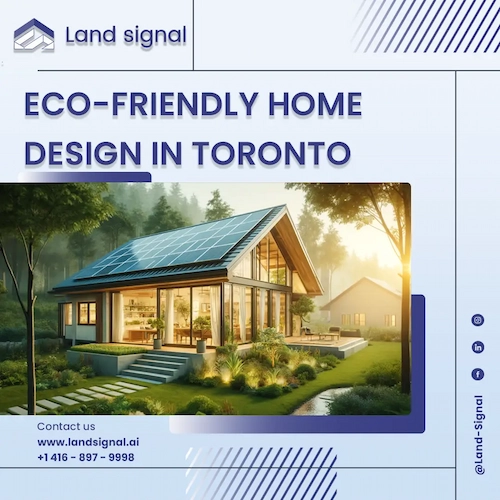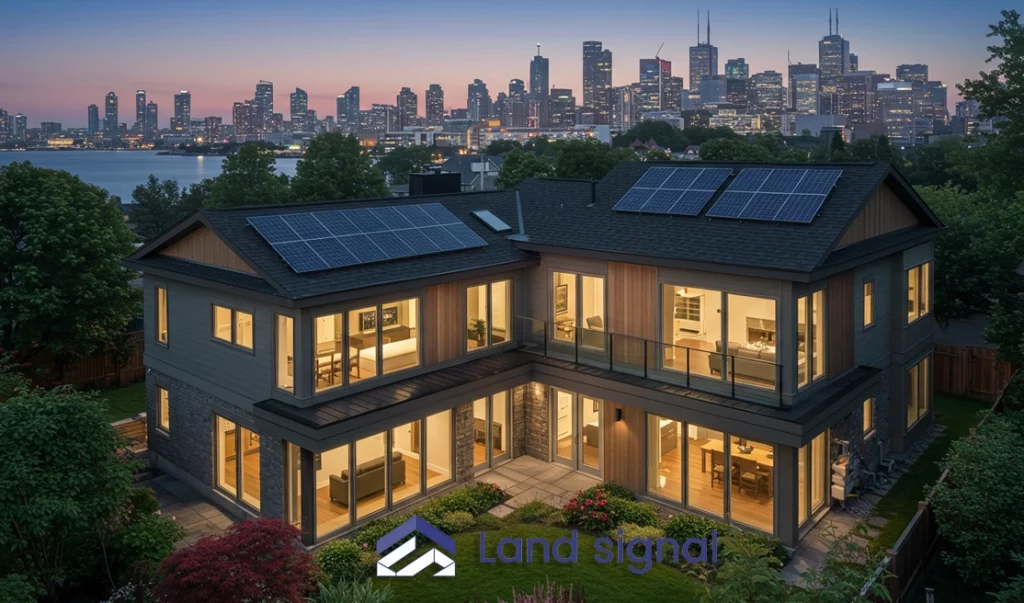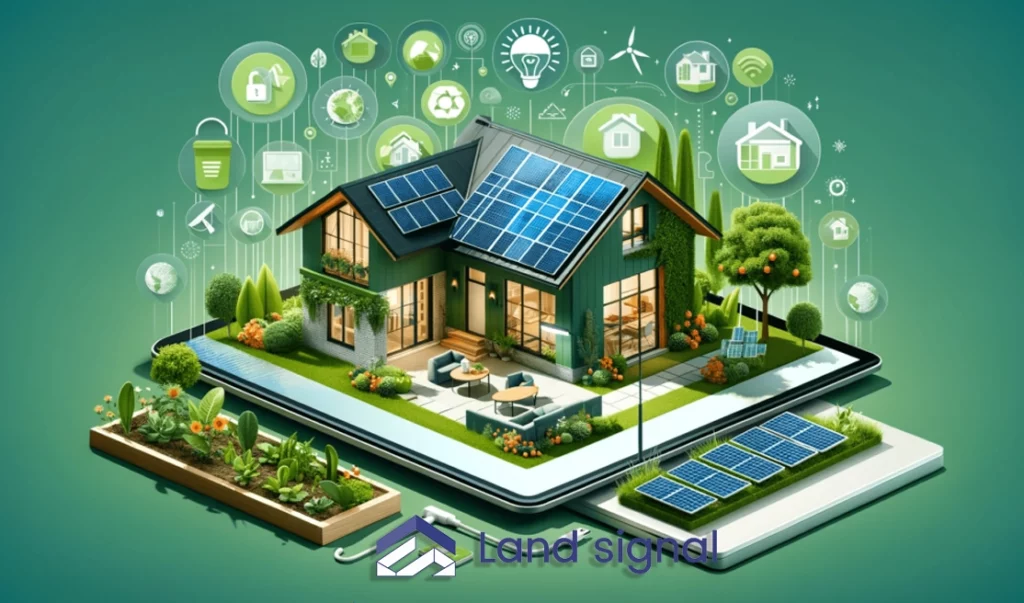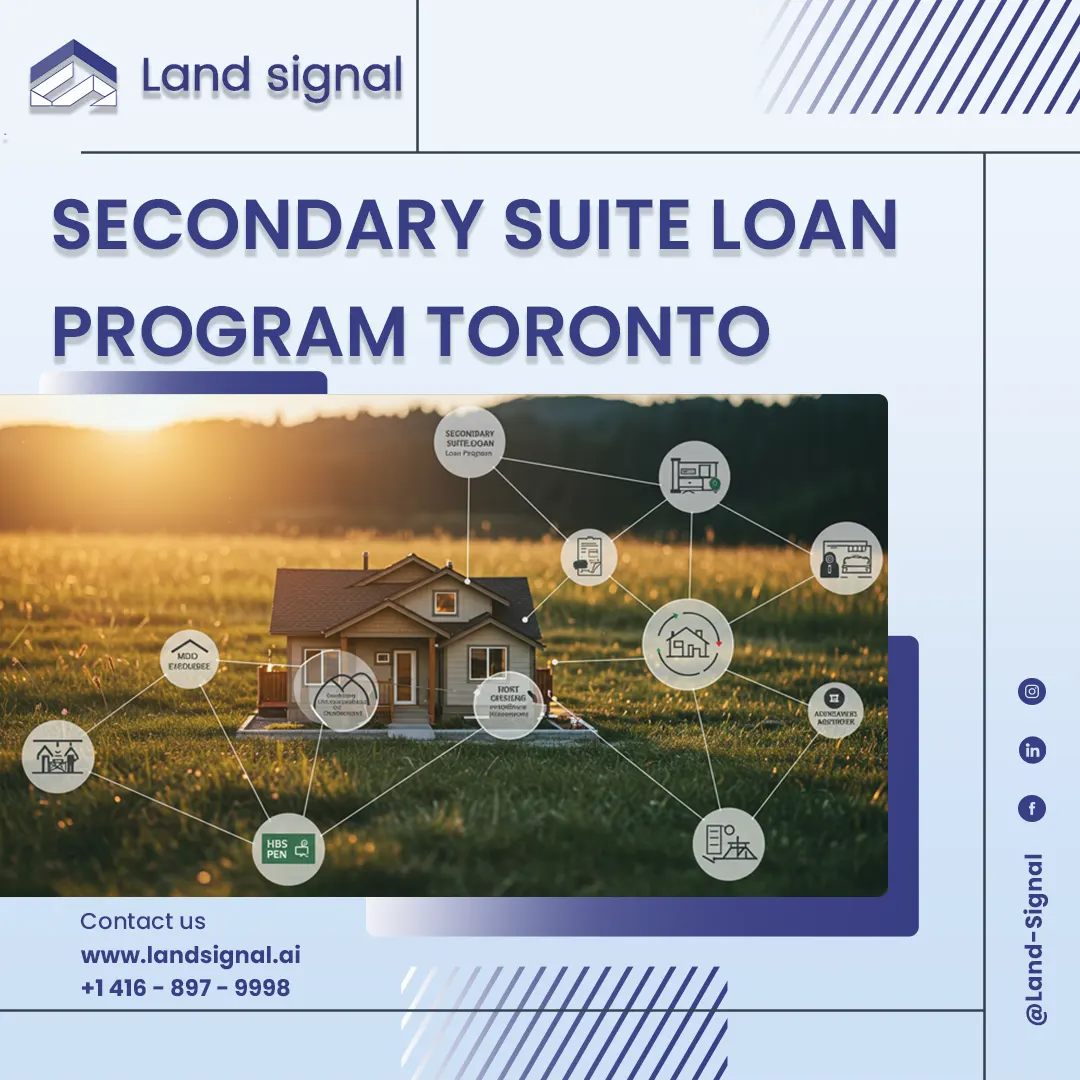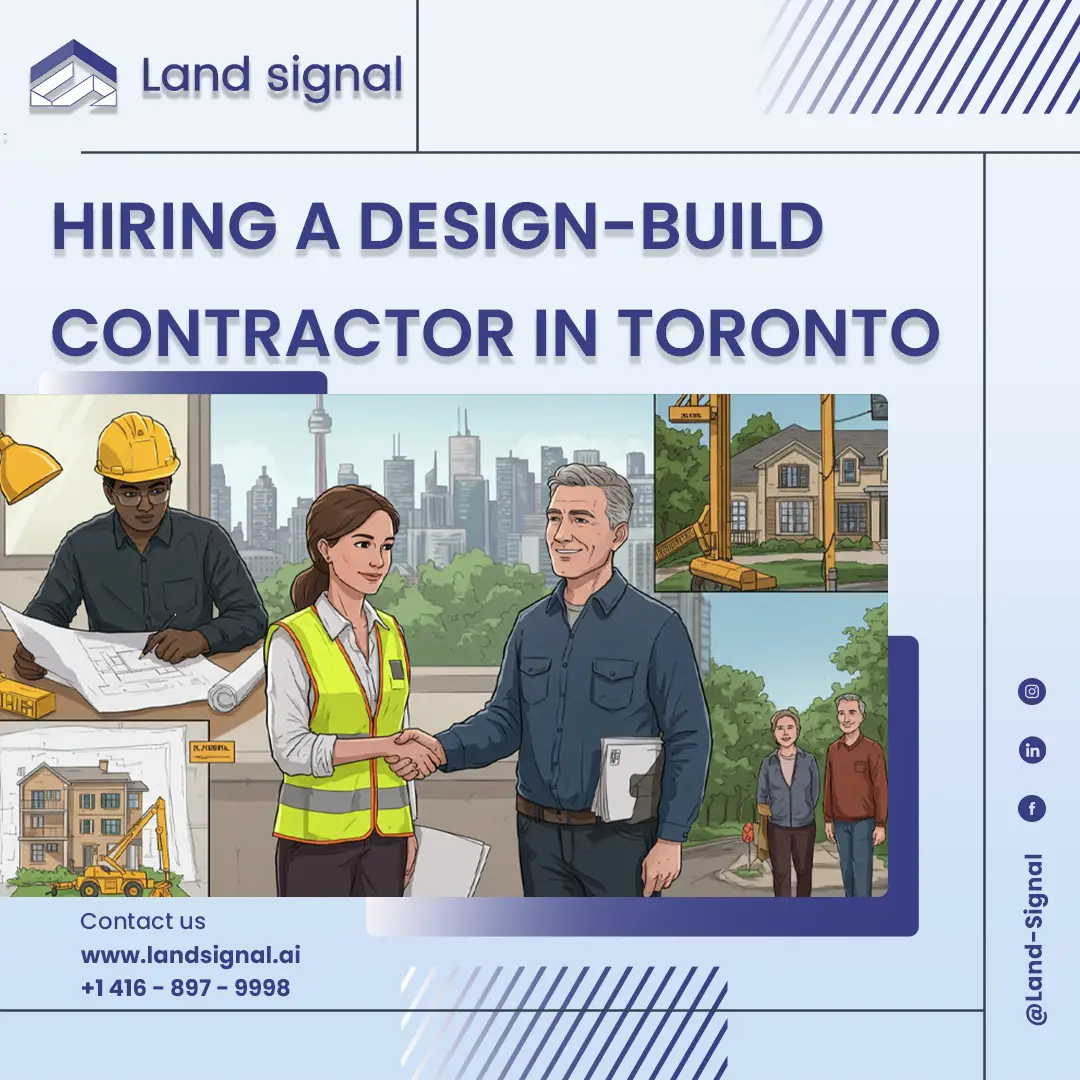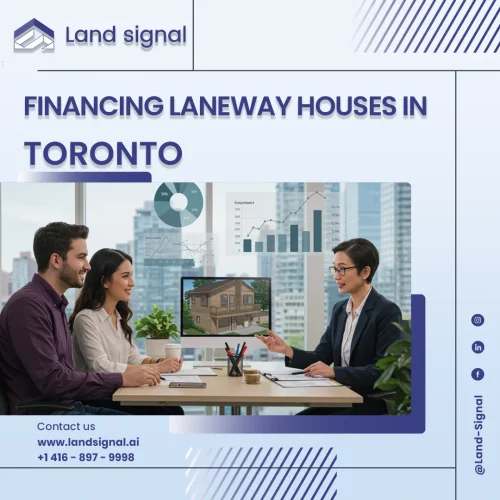In the face of escalating environmental concerns and a growing awareness of sustainable living, eco-friendly home design has emerged as a critical approach to residential construction and renovation in Toronto. This approach prioritizes minimizing environmental impact while maximizing resource efficiency, occupant health, and long-term cost savings. Eco-friendly home design, also known as green building, incorporates a range of strategies and technologies to create homes that are environmentally responsible, energy-efficient, and healthy for occupants.
This comprehensive guide explores the principles, benefits, and practical implementation of eco-friendly home design in Toronto, providing homeowners with a detailed understanding of how to build or renovate their homes in a sustainable and responsible manner.
Start Your Project with Confidence
At Land Signal, we assist with construction and renovation permits, as well as Garden House and Laneway Suite designs. Let our experts guide you through every step.
What Is Eco-Friendly Home Design in Toronto and Why Is It Important?
Eco-friendly home design in Toronto encompasses a holistic approach to building and renovating homes that minimizes environmental impact throughout the entire lifecycle of the dwelling. This involves careful consideration of site selection, building materials, energy efficiency, water conservation, waste management, and indoor air quality.
The importance of eco-friendly home design stems from the urgent need to address climate change, reduce reliance on finite resources, and create healthier living environments. Toronto, as a major urban center, has a significant environmental footprint, and promoting sustainable building practices is crucial for mitigating the city’s impact on the environment.
Read Also: Net Zero Home Toronto | A Complete Guide
The Benefits of Eco-Friendly Home Design in Toronto
Adopting eco-friendly design principles offers a multitude of benefits for homeowners, the community, and the environment.
Cost Savings in the Long Run
While upfront costs for eco-friendly features may be slightly higher, the long-term cost savings are substantial and often outweigh the initial investment. Energy-efficient appliances, like ENERGY STAR certified refrigerators and washing machines, consume less electricity, directly translating to lower monthly hydro bills. Effective insulation, such as blown-in cellulose or spray foam, minimizes heat transfer, reducing the need for excessive heating in the winter and air conditioning in the summer.
High-performance windows, particularly those with low-E coatings and argon gas fills, further enhance energy efficiency and contribute to lower utility costs. Water-saving fixtures, including low-flow toilets, faucets, and showerheads, minimize water usage without sacrificing performance, leading to lower water bills.
Drought-tolerant landscaping reduces or eliminates the need for irrigation, further lowering water expenses and promoting water conservation. These long-term savings can offset the initial investment and provide significant financial benefits over the lifespan of the home.
Read Also : Garden Suite Design Toronto
Improved Health and Well-Being
Eco-friendly homes prioritize the health and well-being of occupants by creating a healthier and more comfortable indoor environment. The use of non-toxic building materials, such as low-VOC paints, adhesives, and finishes, minimizes exposure to harmful chemicals and improves indoor air quality, reducing the risk of respiratory problems and allergies.
Proper ventilation systems, including HRVs and ERVs, ensure a constant supply of fresh, filtered air, further enhancing indoor air quality and promoting respiratory health. Natural lighting and connections to the outdoors, achieved through strategically placed windows and biophilic design principles, improve mood, reduce stress, and create a more pleasant and comfortable living space.
Environmental Impact Reduction
Eco-friendly design significantly reduces a home’s environmental footprint by minimizing its impact on natural resources and reducing greenhouse gas emissions. Reduced energy and water consumption translate to lower greenhouse gas emissions, contributing to the fight against climate change.
The use of sustainable building materials, such as sustainably harvested lumber and recycled materials, minimizes deforestation and reduces the environmental impact of manufacturing and transportation. By prioritizing resource efficiency and waste reduction, eco-friendly homes contribute to a more sustainable future.
Increased Property Value
Eco-friendly features are becoming increasingly desirable in the real estate market, adding value to homes and attracting environmentally conscious buyers. Homes with green certifications, such as LEED or Built Green, demonstrate a commitment to sustainability and command higher market prices.
Energy-efficient features, like solar panels and high-performance windows, are highly sought after by buyers looking to reduce their utility costs. This increased demand for sustainable housing translates to higher resale values and a faster sales process for eco-friendly homes.
Greater Comfort and Efficiency
Eco-friendly homes are designed to be more comfortable and efficient, providing a more pleasant and consistent indoor environment. Proper insulation, high-performance windows, and efficient HVAC systems work together to maintain a consistent indoor temperature, reducing drafts and temperature fluctuations, leading to enhanced comfort and reduced energy waste.
Natural lighting and ventilation create a more pleasant and comfortable living environment, reducing reliance on artificial lighting and mechanical ventilation. This creates a healthier, more comfortable, and more enjoyable living space.
Improved Indoor Air Quality
Eco-friendly design prioritizes indoor air quality by minimizing the use of volatile organic compounds (VOCs) in building materials and finishes, promoting a healthier indoor environment. Proper ventilation systems, including HRVs and ERVs, ensure a constant supply of fresh, filtered air, reducing indoor pollutants and improving respiratory health.
Using low-VOC paints, adhesives, and finishes further reduces indoor air pollutants and promotes a healthier indoor environment, minimizing the risk of respiratory issues and allergies.
Key Elements of Eco-Friendly Home Design in Toronto
Several key elements contribute to a truly eco-friendly home.
Energy Efficiency
Energy efficiency is a cornerstone of eco-friendly design. This involves implementing strategies to minimize energy consumption for heating, cooling, lighting, and appliances, reducing reliance on fossil fuels and lowering greenhouse gas emissions.
High-performance insulation, airtight construction, energy-efficient windows and doors, and Energy Star-rated appliances are crucial for reducing energy waste and lowering utility bills. Utilizing renewable energy sources, such as solar panels or geothermal systems, can further reduce reliance on fossil fuels and contribute to a net-zero energy home.
Water Conservation
Water conservation is another critical aspect of eco-friendly design. Low-flow toilets, faucets, and showerheads reduce water usage without compromising performance, contributing to water conservation efforts. Rainwater harvesting systems can collect rainwater for irrigation and other non-potable uses, reducing reliance on municipal water supplies. Drought-tolerant landscaping reduces the need for outdoor watering, further conserving water and promoting biodiversity.
Sustainable Materials
Choosing sustainable building materials is essential for minimizing environmental impact. This involves selecting materials that are renewable, recycled, locally sourced, and have low embodied energy, reducing the environmental footprint of construction. Examples include sustainably harvested lumber, recycled plastic lumber, bamboo flooring, and recycled glass countertops. Avoiding materials with high VOC content is crucial for maintaining healthy indoor air quality and minimizing exposure to harmful chemicals.
Indoor Air Quality
Maintaining healthy indoor air quality is paramount in eco-friendly design. Proper ventilation systems, including heat recovery ventilators (HRVs) and energy recovery ventilators (ERVs), ensure a constant supply of fresh air while minimizing energy loss, promoting a healthy and comfortable indoor environment. Using low-VOC paints, adhesives, and finishes reduces indoor air pollutants and promotes respiratory health, minimizing exposure to harmful chemicals and improving overall well-being.
High-Performance Windows and Doors
High-performance windows and doors play a crucial role in energy efficiency and overall building performance. Double or triple-paned windows with low-E coatings minimize heat transfer, reducing energy loss in winter and heat gain in summer, contributing to lower energy bills and enhanced comfort. Properly sealed and insulated window and door frames further enhance energy performance and minimize drafts.
The Cost of Eco-Friendly Home Design: Balancing Investment and Returns
Understanding the financial implications of eco-friendly design is essential for informed decision-making.
Upfront Green Costs
While some eco-friendly features may have slightly higher upfront costs compared to conventional options, it’s important to consider the long-term benefits and overall return on investment. Investing in high-quality insulation, energy-efficient appliances, and sustainable materials may increase initial construction costs, but these investments are offset by long-term energy and water savings, ultimately reducing monthly expenses and increasing the value of the home.
Long-Term ROI
The long-term return on investment (ROI) of eco-friendly design is substantial, encompassing both financial and intangible benefits. Reduced energy and water bills, increased property value, and potential tax incentives or rebates contribute to a positive ROI over the lifespan of the home. Furthermore, the intangible benefits of improved health, comfort, and environmental responsibility add significant value, enhancing quality of life and contributing to a more sustainable future.
Read Also: Home Building Cost Calculator Ontario
Getting Started: Your Path to an Eco-Friendly Home in Toronto
Embarking on an eco-friendly home project requires careful planning and execution.
Plan Your Green Project
Clearly define the scope and objectives of your green building project. Determine whether you’re building a new home or renovating an existing one, considering the specific challenges and opportunities associated with each approach. Identify your priorities, whether it’s maximizing energy efficiency, minimizing water usage, or using sustainable materials.
Setting clear goals will guide your decision-making throughout the project and ensure that your vision is realized effectively. Consider consulting with a green building professional to develop a comprehensive plan that aligns with your budget and sustainability goals.
Key Success Steps
- Research and Education: Thoroughly research eco-friendly building practices, materials, and technologies. Attend workshops, webinars, and green building tours to gain a deeper understanding of sustainable design principles.
- Professional Guidance: Engage experienced professionals, including architects, engineers, and contractors specializing in green building. Their expertise is invaluable for navigating the complexities of eco-friendly design and construction.
- Budgeting and Financing: Develop a realistic budget that incorporates the costs of eco-friendly features. Explore financing options, including green mortgages and government incentives, to support your sustainable building project.
- Certification Programs: Consider pursuing green building certifications, such as LEED (Leadership in Energy and Environmental Design) or Built Green, to validate the sustainability of your home and potentially increase its market value.
Conclusion
Eco-friendly home design is not merely a trend but a necessary shift towards a more sustainable future. By embracing green building principles, homeowners in Toronto can create homes that are environmentally responsible, energy-efficient, healthy, and comfortable. While the upfront costs may be slightly higher, the long-term benefits, including cost savings, improved health, and increased property value, far outweigh the initial investment.
By carefully planning, seeking professional guidance, and prioritizing sustainability, homeowners can build or renovate their homes in a way that benefits both themselves and the environment. Eco-friendly home design is an investment in a healthier, more sustainable future for Toronto and the planet.

